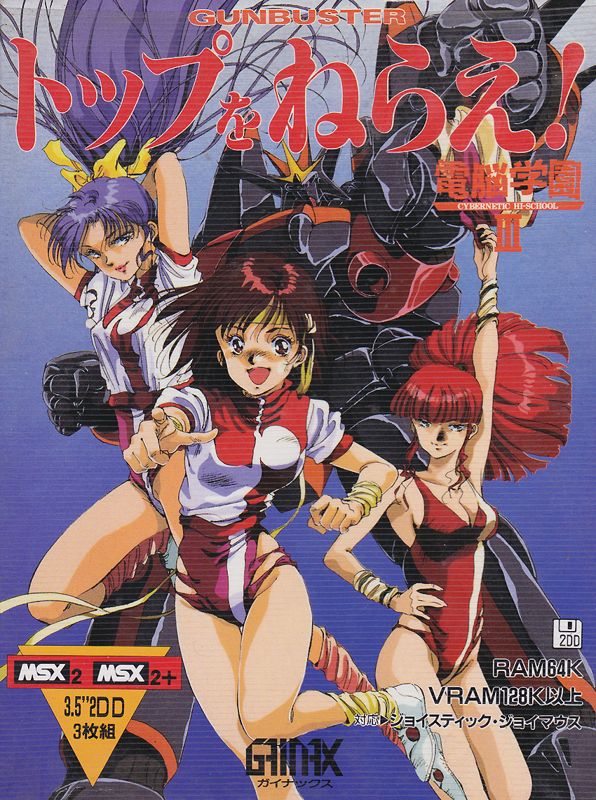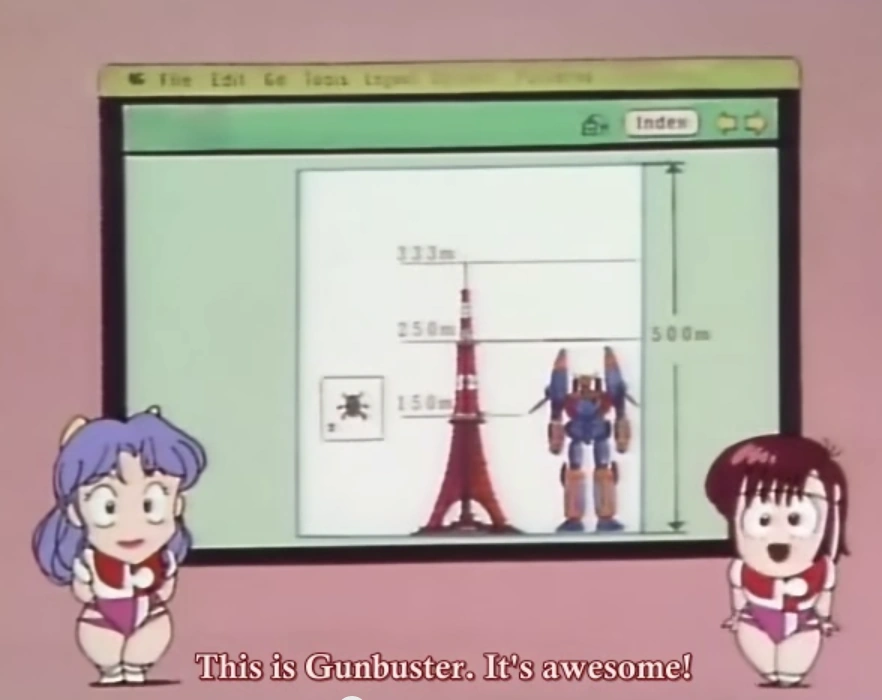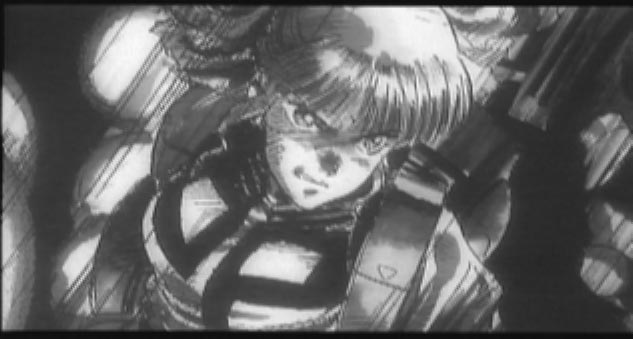 |
| From https://www.mobygames.com/images/covers/l/254841- cybernetic-hi-school-part-3-gunbuster-msx-front-cover.jpg |
a.k.a Aim for the Top! Gunbuster
Director: Hideaki Anno
Screenplay: Hideaki Anno,
Hiroyuki Yamaga and Toshio Okada
Voice Cast: Noriko Hidaka as
Noriko Takaya; Rei Sakuma as Kazumi "Onee-sama" Amano; Kazuki Yao as
Smith Toren; Maria Kawamura as Jung Freud; Masako Katsuki as Kimiko Akai/Reiko
Kashiwara; Norio Wakamoto as Kouichiro "Coach" Ohta; Tamio Ohki as
Captain Tatsumi Tashiro
Synopsis: In the future, Noriko Takaya (Noriko Hidaka) is a young student at a high school that trains robot
pilots to protect the Earth from a hostile alien race. Hoping to follow her
father's example, lost to outer space, she strives to become the best
regardless of any doubts and handicaps in front of her.
[Major Spoilers Throughout]
Gunbuster has not been helped by its chequered history in terms of
availability in the West, nor the potential and pointless handicap in terms of marketability
of never having an English dub, is nonetheless a legendary work from Gainax. I will state, outright, that any
flaws that I find in the work are subsumed by the lasting thoughts of all Gunbuster does right and what an
ambitious project the then-fledgling studio was with hindsight. Being
sandwiched between Royal Space Force:
The Wings of Honnêamise (1987), arguably Gainax's most intelligent and
ambitious projects, and the cultural behemoth that was Neon Genesis Evangelion (1995) doesn't help either as whilst Gainax's legacy is strong due to so many
idiosyncratic titles, it does unfortunately mean they have to be jostled in
competition for superiority when they're all good.
Six episodes is actually not a
lot in terms of length for Gunbuster
as, thirty minutes each, they aren't a lot of time for a work which had a bit
of ambition beyond its initial premise. In particular it is a curious hybrid of
genres and styles that is definitely of the eighties with its synth pop music
and style but visibly leaning towards the next decade in themes and tonal
shifts. The first episode of Gunbuster
however always completely betrays what your expectations are, and also prepare
you for the brave if erratic structure of the OVA, that it is entirely an extended
parody of the sports drama, in which protagonist Noriko Takaya is the plucky
heroine who is chosen to go into outer space, much to the derision of other
students, and thus must prove herself to "Coach" Kouichiro Ohta. That
it's entirely through giant pilot robots we see using giant skipping ropes, jog
across the track and field, and do push-ups is inherently (and deliberately) humorous,
right down to a pastiche of Vangelis'
Chariots of Fire (1981) score that
was removed in subsequent releases.
 |
| From http://animuze.com/blog/wp-content /uploads/2017/01/gubusterscreepcap3-1024x773.jpg |
This belies Hideaki Anno's directorial career, how he juxtaposes tones to an extreme. The eighties aesthetic, alongside incredible and painstakingly hand drawn animation, even includes a vibrant and frankly un-cool sweetness to the proceedings, the opening and ending credit songs even into the darker later episodes cute synth pop about striving to be the best, the end credits one even set over crayon drawn comedy gag stills for emphasis. The sense of humour is to be found as well in the omake, made for the series during its production and even with a few additions for later releases, which are parodies of short science lessons where the science by the cast, all drawn in "chibi" form (squat, exaggerated versions like gnomes), is detailed and realistic but utterly made-up. The gag in Episode 3 of having a character's full and convoluted scientific dissertation in white text on a black background, whilst a karaoke duet about a man and a woman getting drunk takes place between the casts' off-time, is just a cherry on the cake for this playfulness. Between these and the first episode, Gunbuster starts off as a light hearted sci-fi romp but it's already establishes clues to where the plot will go.
And in taking such risks, Hideaki Anno having to sacrifice pace
for this tonal shifting, there are issues to be had. There is something very
unique, in context of when the OVAs were first released in the late eighties,
where this even in the early episodes can still have the humour and titillating
fan service, introducing a space station and characters like the Russian female
pilot Jung Freud with additional space bathing, whilst there's still the gravity
of the threat, the alien forces truly monstrous multi-coloured bio-mechanical
masses who implant eggs into suns and planets destroying them, the plot
emphasising that this feels like humanity fighting against a natural process of
the universe in desperation. Some of the risks haven't aged well, mainly
episode third to be honest because it falls on a trope, introducing a character
only to kill them off in that same piece, that's been done better elsewhere. It's
famous for calling a character for that episode Smith Toren, named after the
Canadian manga translator and founder of Studio Proteus who had first hand
interaction with Gainax staff through
his contributions to Western anime and manga fan culture. It's a wonderful
tribute to the late Toren, but as the first crush of Noriko's it does have to
be compared to other examples of one character being introduced to an episode
and a tragedy taking place, to which Kaiba
(2008) and a very early episode of Full
Metal Alchemist (2003) show a lot more nuisance to this risk.
 |
| From https://sqwabb.files.wordpress.com/2013/07/gunbuster-dilation.jpg |
It certainly predates by decades Christopher Nolan's Interstella (2014) in terms of the idea of time dilation, an irony that Nolan's career is practically cursed by anime works which predate his films (Paprika (2006) < Inception (2010) for another example) and does the ideas better. The entire plot of Noriko's trajectory, in lieu as well to the time dilation, becomes one of Gunbuster's greatest successes. Bear in mind, whilst it's named after a monolithic robot that is Earth's secret super weapon, one of the largest in anime still until Gainax's own Gurren Lagann (2007) got ridiculous, is only introduced in action in the last minutes of episode four. Instead, alongside a sense of hope and courage against dire situations, it's the emotional drama which Gunbuster tries its damndest with and succeeds with completely.
It gets melodramatic, plot twists
exposed as it weaves Noriko's own conflicts with her abilities with her senior
and co-pilot Kazumi Amano's romanctic longings for Coach, Noriko's own doubts
and fears fighting the aliens especially confounded by the time dilation, where
merely a few hours in space are months on Earth, those she loves like her high
school friend aging as she is still a teenager. The swipe at Christopher Nolan's Interstellar is actually appropriate, as, its legitimately arguable
Gunbuster is a more subtle work that
tackles the subject more fully, as characters' lives beyond the story are what Hideaki Anno actually deals with rather
than the giant robot versus alien plot the likes of me expected. And yes, it absolutely
sets up Anno's own career trajectory
as Neon Genesis Evangelion, even
having the silly humour in early episodes, would do the same thing. The marvel
is that the proud otaku who by all accounts still plays with Ultraman toys in the bathtub was always
interested in human emotions for his pulp characters from the get-go in his
career.
 |
| From https://deculture101.files.wordpress.com/2008/12/vlcsnap-5083404.jpg |
Also in terms of production, Gainax cannot be accused of being poor, even into the 2000s when their reputation weathers financial and political strife in-house and questionable projects are started, because they always have had very distinct works in premise, aesthetic and. Fully embracing high sci-fi here, there's an attention to detail in even the mechanics of spaceships of the imagination that even a laymen to animation would applaud. As the story takes risks, so the hard work on the production is likewise the same.
Then episode six, the last,
appears and whilst its one of the best of any OVA or TV series, it makes a case
that whilst he's one of Gainax's best
voices before departing for his own studio called Studio Khara, Anno at
least to the 2000s was cursed for real, as his output from here to the late
nineties shows. Nadia: The Secret of
Blue Water (1990-1), a NHK/Toho/Korad
co-production, took a turn when the infamous "island" episodes had to
be made to pad out the series, filler so bad it traumatises viewers to this
day. Neon Genesis Evangelion's
production history is very well documented, Anno's
mental health issues so bad that later next episode previews were actual
sketches rather than animation and the more overt experimentation came in as
much for practicality. Anyone who has seen The
End of Evangelion (1997) can attest to where that went to traumatise viewers
and His and Her Circumstances (1998-9)
had the unfortunate scenario where the original authoress hated where the
series went with her source material, affecting it as it went along. Anno is a good argument for the auteur
theory even in terms of how this streak of bad luck, the chaotic production
histories, helped shape the final materials as much as his hard work.
 |
| From https://vignette.wikia.nocookie.net/gunbuster/ images/a/a6/It_big.png/revision/latest?cb=20150820201753 |
Gunbuster's no different as it immediately starts in monochrome; the last episode barring the final moment is entirely animated in black-and-white and the result is a drastic change in tone because of this. It is stylish but it's clearly a production or financial issue which caused this as for a major space battle between the aliens and Earth's space fleets, it's depicted entirely in a montage of still shots and a text scrawl documenting the survivor numbers afterwards1. And yet, in spite of this, ultimately Gunbuster succeeds as it rakes the viewer over the coals in sadness yet is actually a triumphant, happy ending on display, one of the few examples in any art where a story justifies its happy conclusion by making it a worthy thing succeeded in acquiring. And that's why, flaws and all, I see Gunbuster works and know why it's beloved, a very idiosyncratic work that would be a breath of fresh air back in the late eighties, still idiosyncratic today.
Admittedly that's in mind of it
being a show of such a status that's not easily available, the existence of a
theatrical cut which removes material that was also released in the West
complicated things. As even Evangelion
has been picked up by Netflix and to
be made available again, Gunbuster
is one of the last jewels in Gainax's
crown that is harder to glimpse, not helped that whilst worthy of its own
stature, the ill-advised decision to effectively sell Diebuster (2004-6) as Gunbuster
II in the West didn't go down so well, a show set in the same world (and in
hindsight, mirroring the ending of Gunbuster
with its own ending with a greater meaning now for me) but an entirely
different animal. The talk about Diebuster
however is for another day...Gunbuster,
the prequel, is something that needs to return back in availability.
 |
| From https://www.forbiddenplanet.org/Gunbuster/Visual/Episode6/gb604.jpg |
======
1) And not necessarily because
the black-and-white ink instead of colour being used was a cost cutting measure
either...either way, the final episode finds a way to overcome material limitations
as is another trademark of Hideaki Anno's.
No comments:
Post a Comment